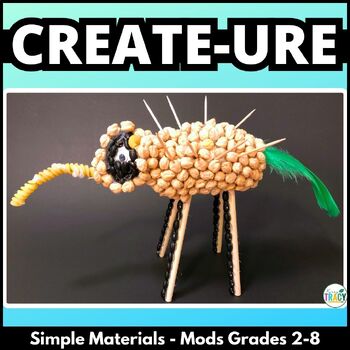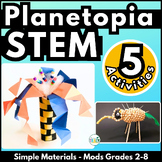Create-ure Spring STEM Challenge Activity with Life Science Extensions
- Zip
What educators are saying
Also included in
- 52 NGSS-aligned STEM challenge activities to build engagement, critical thinking, & problem-solving all year long! These are easy STEM activities to implement, use simple materials, and include modifications for grades 2 - 8. The basic idea: Students work in partners or groups against criteria &Price $59.99Original Price $184.89Save $124.90
- If your science standards include landforms, plate tectonics, the water cycle, weather, natural disasters, plant parts, plant cells, animal cells, life cycles, and/or heredity & genetics, Planetopia Project STEM Challenges are perfect to engage your students in brain-busting work (disguised as fPrice $9.99Original Price $20.43Save $10.44
- Super-charge your STEM class with 52 high-engagement, critical thinking, problem-solving, NGSS-aligned challenges to take you through the entire year! Modifications are included to make these activities engaging and challenging for students in grades 2 - 8.The basic premise: Students work in partnerPrice $99.99Original Price $372.00Save $272.01
- If you’re looking to apply learning in adaptations, habitats, food chains and food webs, life cycles, genetics & heredity, evolution, and/or human body systems, this STEM / STEAM challenge is a perfectly engaging way to get the job done joyfully!It’s perfect for Halloween or spring, but works anPrice $6.98Original Price $9.96Save $2.98
Description
If you’re looking to apply learning in adaptations, habitats, food chains and food webs, life cycles, genetics & heredity, evolution, and/or human body systems, this STEM or STEAM challenge is a perfectly engaging way to get the job done joyfully!
It’s the perfect Halloween or spring STEM activity, but it works any time of the year to connect to your life science standards!
The basic idea:
Students work in individually or in partners or groups against a list of criteria and constraints to create a create-ure that has never been seen or imagined before.
Note: This is the printable version, though you can upload the editable version of student handouts to Google Slides™. However, if you are in a 1:1 / paperless classroom, you may prefer the digital option designed specifically for use with GOOGLE SLIDES™.
If you have questions about which version is right for you, please feel free to leave me a question using the product Q&A below.
This resource is also available in the following discounted bundles:
⭐ Planetopia Project STEM Challenge Bundle
⭐ STEM Challenges: Year-Round Mega Bundle
⭐ The Ultimate STEM Challenge Mega Bundle
⭐️ Resource includes:
✅ NGSS aligned standards, Grades 2 – 8
✅ Teacher Tips
- Links to a video walk-through of the challenge & my STEM Challenge PD video series
- Premise & Set-up
- Materials and timing
- Modifying Criteria & Constraints to adjust challenge difficulty
- Measuring results
- Post-design extension activities list & links
✅ EDITABLE Student Handouts
- Criteria and Constraints list
- Design Analysis Handouts (in color and B&W in two versions: 4-page expanded room for response and 2-page condensed space version for older students)
- Discussion Questions
✅ Extension templates
- Process flow map
- Create & solve math problems based on designs
- Life Science Folder/Booklet Project templates (editable):
- General Information
- Feature Spotlight
- Life Cycle
- Where in the World? (Habitats)
- Food Chain / Food Web
- Animal Classification
- Geologic Time Scale
- Genetics / Heredity
- Evolution
- Body Systems Compare/Contrast
Materials you’ll need to do the activity are easily modified. I’ve done the challenge with nothing more than newspaper, tape, and pipe cleaners and it worked well. However, as with all challenges, the more varied the materials, the more varied the designs!
Sample/suggested materials for each student or group:
- Newspaper or tissue paper
- Construction paper
- Craft sticks
- Pipe cleaners
- Sequins
- Yarn
- Pom poms
- Googly eyes
- Paint
- Feathers
- Toothpicks
- Scissors
- Foil
- Cotton
- Felt
- Sand paper
- Glue
- Masking tape
- Hot glue guns
- Plastic wrap or sandwich baggies
- Uncooked noodles, rice, and/or beans
- Design analysis handouts (included)
You may also like these products:
⭐Characteristics of Living Things
⭐Halloween STEM Challenge 5-in-1 Bundle
⭐Twilight Zone Plot Diagram, Summary, and Writing Activities (5th– 8th)
⭐Photosynthesis: Hands-on Modeling Activity
⭐Oral and Written Communication Skills Task Cards: Halloween
Video preview music credit:
"Carefree" Kevin MacLeod (incompetech.com)
Licensed under Creative Commons: By Attribution 3.0 License
http://creativecommons.org/licenses/by/3.0/









